Jieru Zhao
Efficient Unified Caching for Accelerating Heterogeneous AI Workloads
Jun 14, 2025Abstract:Modern AI clusters, which host diverse workloads like data pre-processing, training and inference, often store the large-volume data in cloud storage and employ caching frameworks to facilitate remote data access. To avoid code-intrusion complexity and minimize cache space wastage, it is desirable to maintain a unified cache shared by all the workloads. However, existing cache management strategies, designed for specific workloads, struggle to handle the heterogeneous AI workloads in a cluster -- which usually exhibit heterogeneous access patterns and item storage granularities. In this paper, we propose IGTCache, a unified, high-efficacy cache for modern AI clusters. IGTCache leverages a hierarchical access abstraction, AccessStreamTree, to organize the recent data accesses in a tree structure, facilitating access pattern detection at various granularities. Using this abstraction, IGTCache applies hypothesis testing to categorize data access patterns as sequential, random, or skewed. Based on these detected access patterns and granularities, IGTCache tailors optimal cache management strategies including prefetching, eviction, and space allocation accordingly. Experimental results show that IGTCache increases the cache hit ratio by 55.6% over state-of-the-art caching frameworks, reducing the overall job completion time by 52.2%.
STREAMINGGS: Voxel-Based Streaming 3D Gaussian Splatting with Memory Optimization and Architectural Support
Jun 09, 2025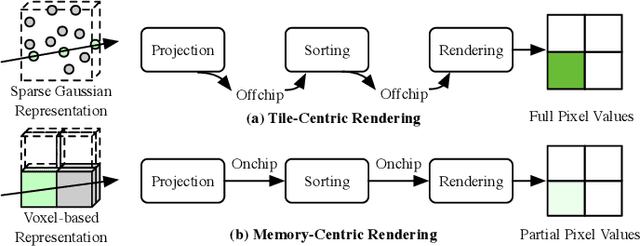



Abstract:3D Gaussian Splatting (3DGS) has gained popularity for its efficiency and sparse Gaussian-based representation. However, 3DGS struggles to meet the real-time requirement of 90 frames per second (FPS) on resource-constrained mobile devices, achieving only 2 to 9 FPS.Existing accelerators focus on compute efficiency but overlook memory efficiency, leading to redundant DRAM traffic. We introduce STREAMINGGS, a fully streaming 3DGS algorithm-architecture co-design that achieves fine-grained pipelining and reduces DRAM traffic by transforming from a tile-centric rendering to a memory-centric rendering. Results show that our design achieves up to 45.7 $\times$ speedup and 62.9 $\times$ energy savings over mobile Ampere GPUs.
LiveVLM: Efficient Online Video Understanding via Streaming-Oriented KV Cache and Retrieval
May 21, 2025Abstract:Recent developments in Video Large Language Models (Video LLMs) have enabled models to process long video sequences and demonstrate remarkable performance. Nonetheless, studies predominantly focus on offline video question answering, neglecting memory usage and response speed that are essential in various real-world applications, such as Deepseek services, autonomous driving, and robotics. To mitigate these challenges, we propose $\textbf{LiveVLM}$, a training-free framework specifically designed for streaming, online video understanding and real-time interaction. Unlike existing works that process videos only after one question is posed, LiveVLM constructs an innovative streaming-oriented KV cache to process video streams in real-time, retain long-term video details and eliminate redundant KVs, ensuring prompt responses to user queries. For continuous video streams, LiveVLM generates and compresses video key-value tensors (video KVs) to reserve visual information while improving memory efficiency. Furthermore, when a new question is proposed, LiveVLM incorporates an online question-answering process that efficiently fetches both short-term and long-term visual information, while minimizing interference from redundant context. Extensive experiments demonstrate that LiveVLM enables the foundation LLaVA-OneVision model to process 44$\times$ number of frames on the same device, and achieves up to 5$\times$ speedup in response speed compared with SoTA online methods at an input of 256 frames, while maintaining the same or better model performance.
Communication-Efficient Diffusion Denoising Parallelization via Reuse-then-Predict Mechanism
May 20, 2025Abstract:Diffusion models have emerged as a powerful class of generative models across various modalities, including image, video, and audio synthesis. However, their deployment is often limited by significant inference latency, primarily due to the inherently sequential nature of the denoising process. While existing parallelization strategies attempt to accelerate inference by distributing computation across multiple devices, they typically incur high communication overhead, hindering deployment on commercial hardware. To address this challenge, we propose \textbf{ParaStep}, a novel parallelization method based on a reuse-then-predict mechanism that parallelizes diffusion inference by exploiting similarity between adjacent denoising steps. Unlike prior approaches that rely on layer-wise or stage-wise communication, ParaStep employs lightweight, step-wise communication, substantially reducing overhead. ParaStep achieves end-to-end speedups of up to \textbf{3.88}$\times$ on SVD, \textbf{2.43}$\times$ on CogVideoX-2b, and \textbf{6.56}$\times$ on AudioLDM2-large, while maintaining generation quality. These results highlight ParaStep as a scalable and communication-efficient solution for accelerating diffusion inference, particularly in bandwidth-constrained environments.
FreeKV: Boosting KV Cache Retrieval for Efficient LLM Inference
May 19, 2025Abstract:Large language models (LLMs) have been widely deployed with rapidly expanding context windows to support increasingly demanding applications. However, long contexts pose significant deployment challenges, primarily due to the KV cache whose size grows proportionally with context length. While KV cache compression methods are proposed to address this issue, KV dropping methods incur considerable accuracy loss, and KV retrieval methods suffer from significant efficiency bottlenecks. We propose FreeKV, an algorithm-system co-optimization framework to enhance KV retrieval efficiency while preserving accuracy. On the algorithm side, FreeKV introduces speculative retrieval to shift the KV selection and recall processes out of the critical path, combined with fine-grained correction to ensure accuracy. On the system side, FreeKV employs hybrid KV layouts across CPU and GPU memory to eliminate fragmented data transfers, and leverages double-buffered streamed recall to further improve efficiency. Experiments demonstrate that FreeKV achieves near-lossless accuracy across various scenarios and models, delivering up to 13$\times$ speedup compared to SOTA KV retrieval methods.
DeepCircuitX: A Comprehensive Repository-Level Dataset for RTL Code Understanding, Generation, and PPA Analysis
Feb 25, 2025



Abstract:This paper introduces DeepCircuitX, a comprehensive repository-level dataset designed to advance RTL (Register Transfer Level) code understanding, generation, and power-performance-area (PPA) analysis. Unlike existing datasets that are limited to either file-level RTL code or physical layout data, DeepCircuitX provides a holistic, multilevel resource that spans repository, file, module, and block-level RTL code. This structure enables more nuanced training and evaluation of large language models (LLMs) for RTL-specific tasks. DeepCircuitX is enriched with Chain of Thought (CoT) annotations, offering detailed descriptions of functionality and structure at multiple levels. These annotations enhance its utility for a wide range of tasks, including RTL code understanding, generation, and completion. Additionally, the dataset includes synthesized netlists and PPA metrics, facilitating early-stage design exploration and enabling accurate PPA prediction directly from RTL code. We demonstrate the dataset's effectiveness on various LLMs finetuned with our dataset and confirm the quality with human evaluations. Our results highlight DeepCircuitX as a critical resource for advancing RTL-focused machine learning applications in hardware design automation.Our data is available at https://zeju.gitbook.io/lcm-team.
ClusterKV: Manipulating LLM KV Cache in Semantic Space for Recallable Compression
Dec 04, 2024



Abstract:Large Language Models (LLMs) have been widely deployed in a variety of applications, and the context length is rapidly increasing to handle tasks such as long-document QA and complex logical reasoning. However, long context poses significant challenges for inference efficiency, including high memory costs of key-value (KV) cache and increased latency due to extensive memory accesses. Recent works have proposed compressing KV cache to approximate computation, but these methods either evict tokens permanently, never recalling them for later inference, or recall previous tokens at the granularity of pages divided by textual positions. Both approaches degrade the model accuracy and output quality. To achieve efficient and accurate recallable KV cache compression, we introduce ClusterKV, which recalls tokens at the granularity of semantic clusters. We design and implement efficient algorithms and systems for clustering, selection, indexing and caching. Experiment results show that ClusterKV attains negligible accuracy loss across various tasks with 32k context lengths, using only a 1k to 2k KV cache budget, and achieves up to a 2$\times$ speedup in latency and a 2.5$\times$ improvement in decoding throughput. Compared to SoTA recallable KV compression methods, ClusterKV demonstrates higher model accuracy and output quality, while maintaining or exceeding inference efficiency.
SparseTem: Boosting the Efficiency of CNN-Based Video Encoders by Exploiting Temporal Continuity
Oct 28, 2024Abstract:Deep learning models have become pivotal in the field of video processing and is increasingly critical in practical applications such as autonomous driving and object detection. Although Vision Transformers (ViTs) have demonstrated their power, Convolutional Neural Networks (CNNs) remain a highly efficient and high-performance choice for feature extraction and encoding. However, the intensive computational demands of convolution operations hinder its broader adoption as a video encoder. Given the inherent temporal continuity in video frames, changes between consecutive frames are minimal, allowing for the skipping of redundant computations. This technique, which we term as Diff Computation, presents two primary challenges. First, Diff Computation requires to cache intermediate feature maps to ensure the correctness of non-linear computations, leading to significant memory consumption. Second, the imbalance of sparsity among layers, introduced by Diff Computation, incurs accuracy degradation. To address these issues, we propose a memory-efficient scheduling method to eliminate memory overhead and an online adjustment mechanism to minimize accuracy degradation. We integrate these techniques into our framework, SparseTem, to seamlessly support various CNN-based video encoders. SparseTem achieves speedup of 1.79x for EfficientDet and 4.72x for CRNN, with minimal accuracy drop and no additional memory overhead. Extensive experimental results demonstrate that SparseTem sets a new state-of-the-art by effectively utilizing temporal continuity to accelerate CNN-based video encoders.
HGS-Planner: Hierarchical Planning Framework for Active Scene Reconstruction Using 3D Gaussian Splatting
Sep 26, 2024Abstract:In complex missions such as search and rescue,robots must make intelligent decisions in unknown environments, relying on their ability to perceive and understand their surroundings. High-quality and real-time reconstruction enhances situational awareness and is crucial for intelligent robotics. Traditional methods often struggle with poor scene representation or are too slow for real-time use. Inspired by the efficacy of 3D Gaussian Splatting (3DGS), we propose a hierarchical planning framework for fast and high-fidelity active reconstruction. Our method evaluates completion and quality gain to adaptively guide reconstruction, integrating global and local planning for efficiency. Experiments in simulated and real-world environments show our approach outperforms existing real-time methods.
AutoVCoder: A Systematic Framework for Automated Verilog Code Generation using LLMs
Jul 21, 2024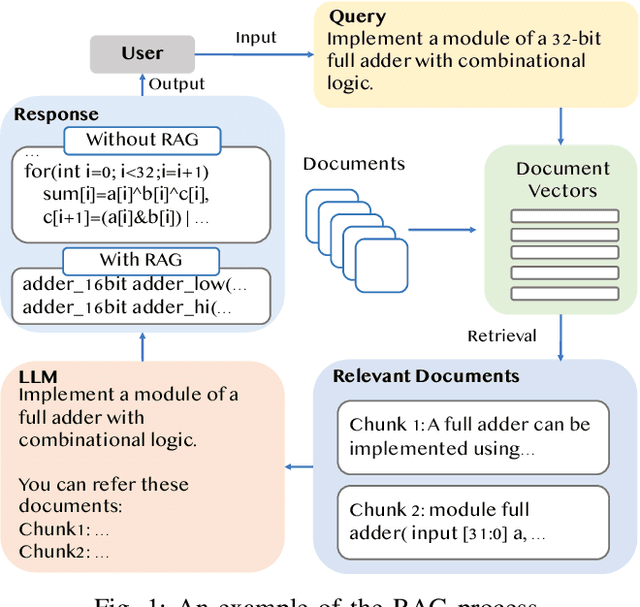
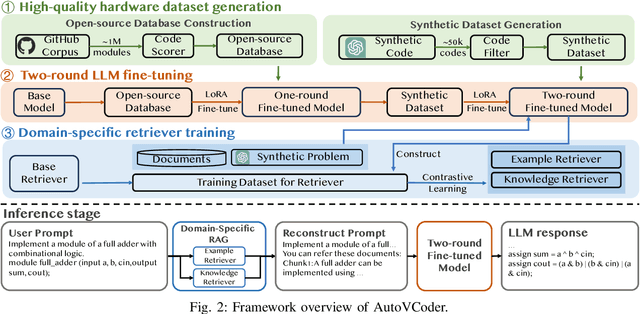
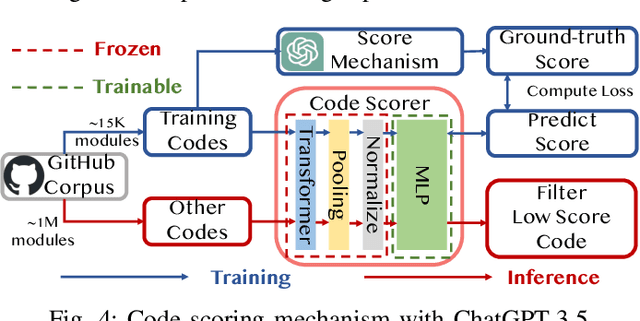
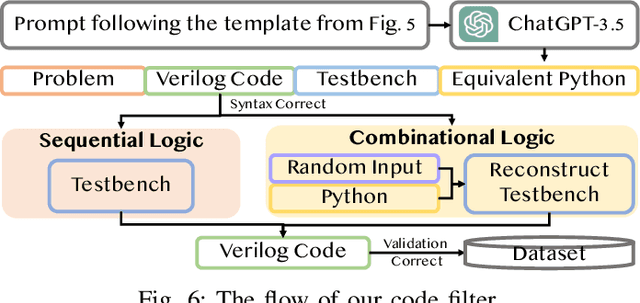
Abstract:Recently, the use of large language models (LLMs) for software code generation, e.g., C/C++ and Python, has proven a great success. However, LLMs still suffer from low syntactic and functional correctness when it comes to the generation of register-transfer level (RTL) code, such as Verilog. To address this issue, in this paper, we develop AutoVCoder, a systematic open-source framework that significantly improves the LLMs' correctness of generating Verilog code and enhances the quality of its output at the same time. Our framework integrates three novel techniques, including a high-quality hardware dataset generation approach, a two-round LLM fine-tuning method and a domain-specific retrieval-augmented generation (RAG) mechanism. Experimental results demonstrate that AutoVCoder outperforms both industrial and academic LLMs in Verilog code generation. Specifically, AutoVCoder shows a 0.5% and 2.2% improvement in functional correctness on the EvalMachine and EvalHuman benchmarks compared with BetterV, and also achieves a 3.4% increase in syntax correctness and a 3.4% increase in functional correctness on the RTLLM benchmark compared with RTLCoder.
 Add to Chrome
Add to Chrome Add to Firefox
Add to Firefox Add to Edge
Add to Edge